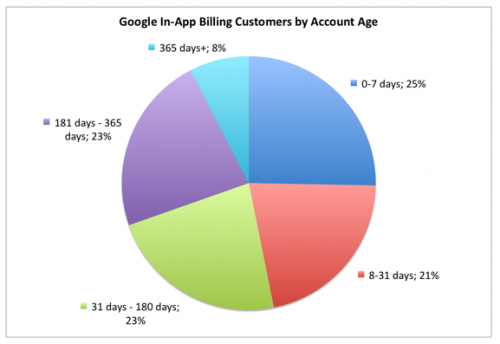开发者对Android Market改进应用计费服务的三大建议
游戏邦注:本文原作者是Android手机游戏开发商Bionic Panda Games联合创始人、SoftTech VC合伙人Charles Hudson,他最近在自己的手机游戏中植入了谷歌官方推出的应用内置计费系统,并借此文代表Android开发者群体提出了他们对谷歌改进应用计费服务的有关建议。
Bionic Panda Games之前的游戏采用的是PayPal计费系统,也有用户要求他们添加信用卡付费选项,该公司于一周前在其首款游戏《Aqua Pets》中推出了谷歌应用内置计费服务,决定先看看这个计费系统的运行效果,并根据采用该服务的用户数量,以及谷歌抽成30%佣金等情况判断这种选择是否划算。
虽然他们并非iOS应用开发商,但通过短期观察他们就发现,苹果向iOS开发商征收30%的佣金其实并无不妥,理由如下:
·苹果已经拥有2亿个以上的用户信用卡帐户,它已为应用开发商带来庞大的付费用户基础,所以苹果理应向开发商征收获取这些用户的相关费用。
·苹果iOS平台一开始就排除了其他计费选项,要求所有用户和开发商只能选择该平台所提供的计费服务,这一点与Facebook等其他平台明显不同。
通过一周的观察,Bionic公司决定深入分析游戏首周付费用户的相关数据。谷歌推出了一个帐号使用年龄的功能“Account Age”,支持开发商查看特定用户通过Google Checkout帐号执行交易的历史,Bionic公司通过该功能制作了第一周付费用户数据图表:
他们发现该图表中深蓝色块的信息最有趣——将近25%的用户使用Google Checkout帐号的时间尚不足一周,他们帐号的实际使用历史在0至1天以内,也就是说,他们是为了购买游戏中的付费功能,才刚注册了Checkout帐号。另外还有21%的用户使用其帐号的时间不满一个月,他们也属于Android生态圈中的新晋付费用户。
作者Charles Hudson称他们非常希望谷歌应用内置计费系统可以迅速获得成功,因为这对该平台的所有免费和付费应用开发商都有益处,但他认为如果谷歌想进一步扩大该计费系统的影响力,就应该考虑三种改进措施:
1.对那些引进Google Checkout新用户的应用开发商提供补贴奖励:对多数开发商来说,如果每个帐号被激活时,谷歌就为开发商提供5至10美元的奖励,就可以极大提高开发商引进新用户的积极性。如果谷歌想收获更多用户,完全可以考虑从补贴开发商的层面入手。
2.强制推行谷歌应用计费系统,将其作为Android Market唯一计费选项:作者认为,该平台如果能全程提供Google Checkout的计费服务,这一点将有助于加深终端用户对谷歌计费系统的印象,有可能因此而进一步扩大其付费用户规模。采纳用户所熟悉的标准化、简化、连贯的结账方式,不但可方便用户购买应用内置付费功能,而且也会给该平台带来更多净收益。
3.取消2011年向应用开发商征收的30%佣金:谷歌征收30%的佣金,也是有些开发商迟迟不肯推出谷歌应用内置计费系统的原因之一。作者建议谷歌在2011年暂时取消这项政策,虽然这可能让谷歌花费一些成本,但这种零成本的交易过程却可以吸引更多开发商采纳该服务,并鼓励用户使用该选项。谷歌可以等到2012年该平台形成了庞大的付费用户规模后,再让这项收费政策复出,因为到那时候开发商已积攒足够的用户基础,并可通过该计费系统创造更多收益。
当然,Android Market是谷歌打造的平台,它有权决定最终作何选择。但作者还是认为,优化Android Market的计费服务是该平台发展过程中所需考虑的头等大事,解决这一问题可形成用户、开发商和谷歌三方同时受益的多赢局面。(本文为游戏邦/gamerboom.com编译,转载请注明来源:游戏邦)
Three Ways Google Could Push Adoption of Android Market’s In-App Billing
[Editor's note: Charles Hudson is a co-author on our Inside Virtual Goods series of industry reports, a co-founder of Android game developer Bionic Panda Games and a partner at SoftTech VC. Bionic Panda recently began using Google in-app billing, which finally came out to consumers at the end of March after several months of anticipation from the Android developer community. Hudson also used to work at Google on new business development.]
We recently decided to launch Google In-App Billing in our first game, Aqua Pets. As a matter of background, we had been using PayPal to monetize our original game and were beginning to get user requests for support for credit cards. About one week ago, we released Google In-App Billing for Aqua Pets and decided to see how it would perform.
Our one major reservation with moving forward with Google in-app billing was the relationship between the 30 percent commission and what we anticipated the payment-enabled customer audience to be. While we don’t develop for the iOS platform, there are two compelling reasons why we think the 30 percent that Apple takes makes sense:
Apple has over 200 million credit cards on file already, so they’re bringing a large payment-enabled audience to application developers and they have every right to charge for access to that audience.
Apple kept alternative options off the platform from the very early days, which meant that just about everyone had to live with the same constraints around what they could and could not used to monetize. This is markedly different from other platforms, such as Facebook
After a week of using Google In-App Billing, we decided to dive into some of the data for our first week of paying users. Google does pass a field called “Account Age” that allows you to determine how long a given user who successfully transacts has had a payment-enabled Google Checkout account. We ran the data on our first batch of paying customers to determine the distribution of account age and charted the data below:
This is an admittedly small sample size of transactions and Google In-App Billing has only been publicly available for less than a month. However, what was of particular interest to us was the dark blue slice — nearly 25 percent of the users who transacted have had Google Checkout payment capabilities for less than a week and a meaningful number of them had account ages of 0 or 1, which means they essentially enrolled in Checkout to purchase in our application. Another 21 percent had only had payment capabilities in Checkout for less than a month, still relatively new to the world of spending money on applications through Google.
We really do want to see Google In-App Billing succeed and succeed quickly — it would be good for anyone building paid or free applications on the Android platform. If I were trying to drive broad adoption, there are three things Google could do and they are not mutually exclusive:
1. Compensate application developers who are enrolling net new Google Checkout customers: One way in which Google could make In-App Billing more attractive to developers would be to pay developers who enroll net-new Google Checkout customers. A small bounty of $5 to 10 per activated account would be interesting for most developers and would give the community a stronger incentive to push it more aggressively to users. A bounty of that size would be inline with what other payment options, namely PayPal, have paid historically to activate new users. It doesn’t seem unreasonable for Google to consider compensating developers who are helping to acquire customers.
2. Make Google In-App Billing mandatory for all application developers and enforce it: One other way to drive more broad adoption of In-App Billing is to strictly enforce usage of Google’s In-App Billing as a required and perhaps exclusive way to pay for in-app purchases across the network of applications in the Google Android Market. I do think that having end-users consistently see the Google Checkout experience across applications will make it feel more familiar and help hopefully grow the base of payment-enabled users. Having a standardized, simple, consistent way to checkout and buy things in apps that feels familiar to all users would be a net benefit for the platform.
3. Waive all of the fees for the rest of the year: One objection that developers have to rolling out Google In-App Billing is the 30 percent commission that Google is charging. There’s a simple solution to that — just remove it for the remainder of 2011. Yes, it will cost Google money. But zero-cost transaction processing is attractive to every developer out there and would likely spur some of the folks sitting on the fence to integrate in-app billing into their apps and encourage users to use it. They can reinstate fees in 2012 with a larger base of installed users and a happier set of developers who’ve seen the benefits of using in-app billing in their own applications.
At the end of the day, it’s Google’s platform and they’re free to do what they choose. But enabling platform-level in-app payments should be a priority and everyone will benefit when the solution is more widely used.(source:insidemobileapps)








































 闽公网安备35020302001549号
闽公网安备35020302001549号